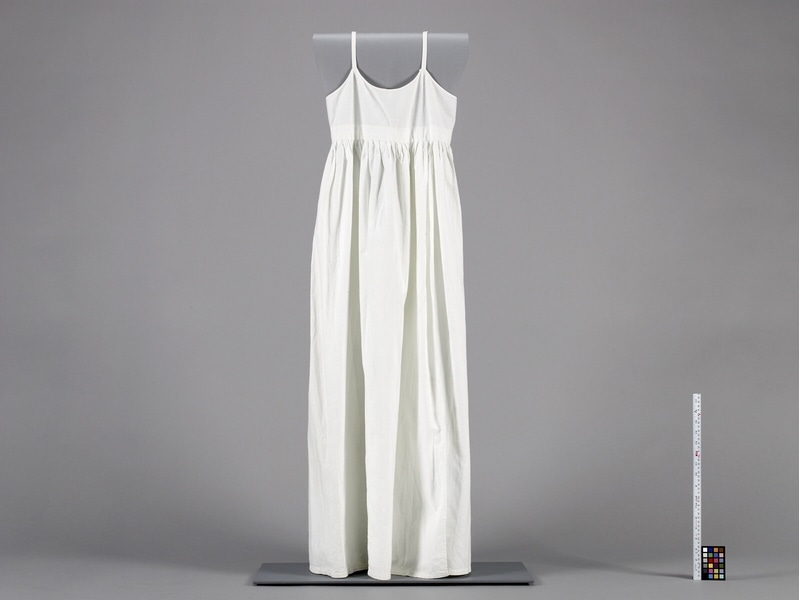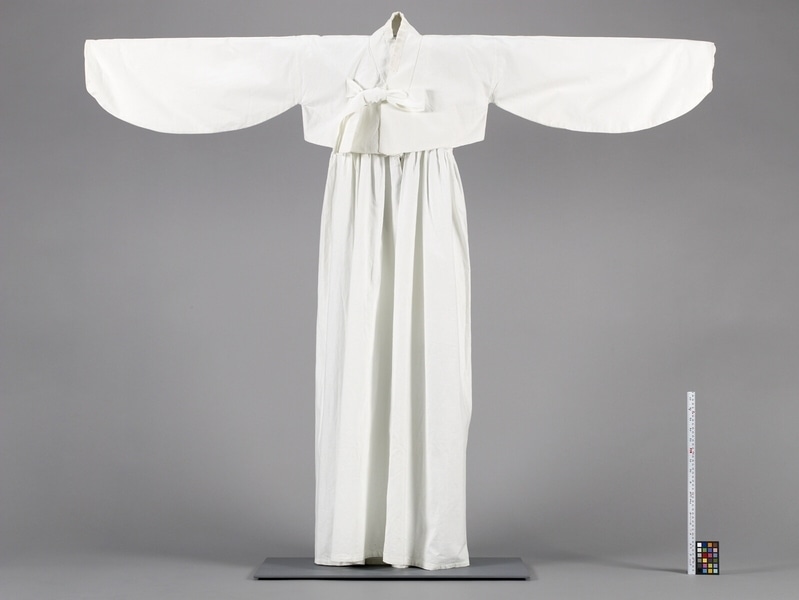Skirt Item Number: 2535/4 from the MOA: University of British Columbia



Description
Skirt made of three panels of heavy white cotton fabric. The skirt is open at the back, where the left panel overlaps the right. The skirt panels are pleated and inserted into a band of white cotton. The upper edge of the band is scalloped with the points of the scallops meeting the ends of two shoulder straps of the same material. A facing covers the upper edges of the pleats on the inside. The band opens at the front and the front seam is left unstitched near the top. Skirt is made to be worn under a jacket (2535/5).
History Of Use
Clothing of good quality white cotton was worn by rural intellectuals, such as teachers, in the 1950s. Good quality cotton and rayon were very precious in the early 1950s in the countryside. In the immediate postwar period ordinary rural people wore clothing made of blanket fabric, or clothing left from the army or obtained from UNICEF. Later those who remained poor wore odd jackets and pants obtained through relief programmes, while those who were more prosperous wore white clothing except for festivals, when coloured clothing was worn. Older men wore long coats “Doo-ru-ma-gui” and horsehair hats. In the winter people wore padded clothing. When rural women worked in the rice paddies, they pulled their skirts up between their legs so they became like pants. They wore the “Jo-go-ri” tight across their breasts. Rural people wore very clean clothes on social occasions. Women washed the clothing in cold mountain streams, and ironed it by beating it against a stone platform with wooden beaters, two women sitting facing each other. “Chi-ma” constructed in this way, opening at the front, but with the opening in the panels at the back, were characteristic of this time. The front opening would have been closed with a safety pin if there mere no hooks and eyes. In the cities, men began wearing western suits during this period, and urban women wore Korean jackets, “Jo-go-ri, and “Chi’ma” in finer materials and bright colours, although by 1958 they, too, began to wear western clothing.
Specific Techniques
Lower edge of band was hand-sewn with stitching that was invisible on the outside. The remainder of the garment was machine-stitched, with narrow seams and double folds at the hem and the edges of the slit..
Narrative
Joan Waddell rarely wore this clothing, as she felt that it represented the Korean people’s identity. She also had padded socks and rubber Korean-style shoes to complete the outfit.
Item History
- Made in Korea between 1953 and 1958
- Collected between 1953 and 1958
- Owned by Joan Waddell before August 18, 2001
- Received from Joan Waddell (Donor) on August 18, 2001
What
Who
- Culture
- Korean
- Previous Owner
- Joan Waddell
- Received from
- Joan Waddell (Donor)
Where
- Holding Institution
- MOA: University of British Columbia
- Made in
- Korea
When
- Creation Date
- between 1953 and 1958
- Collection Date
- between 1953 and 1958
- Ownership Date
- before August 18, 2001
- Acquisition Date
- on August 18, 2001
Other
- Item Classes
- textiles
- Condition
- good
- Accession Number
- 2535/0004